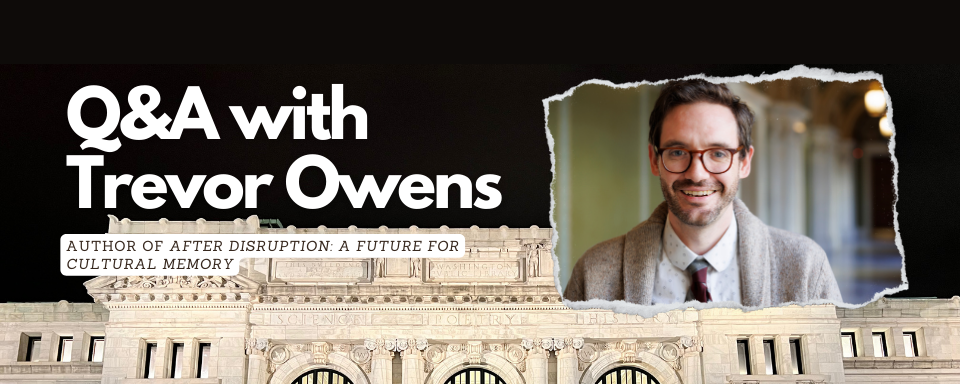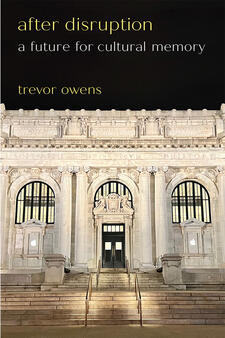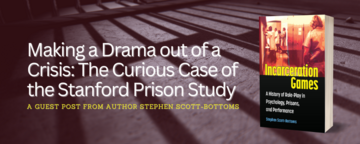Q&A with After Disruption Author Trevor Owens

This guest author post is a Q&A with Trevor Owens, author of the new book After Disruption: A Future for Cultural Memory, from the University of Michigan Press. The book is available in hardcover, paperback, and open access.
Could you tell us a bit about what the term “cultural memory” means and the role of institutions like libraries, archives, and museums?
Cultural memory is our shared memory. The stories of who we are, where we come from, why we are the way we are, and who does and doesn't count as a part of “we” in each case. All of those stories, storytellers, and the artifacts those stories are inscribed on, are where cultural memory comes from. It is an expansive concept. It includes everything you’ve ever been told by someone and everything you ever saw in a video, heard in a podcast, or read in a book or online. Our personal memory, our recollections of our life experiences play a key role in understanding who we are. But even that personal memory is largely full of a range of knowledge, facts, and insights that come from beyond our direct lived experience.
Much of our cultural memory is managed and stored in objects like books, maps, photographs, films, audio recordings, and any number of other artifacts. We have designed institutions like libraries, archives, museums, humanities departments, and research institutes, to collect, preserve, interpret, and help us explore and engage with our shared cultural memory. Importantly, cultural memory is not some static inert thing, it is something that is produced and reproduced continually through a social and dialogic process between various stakeholders.
How has our digital age disrupted the normal function of cultural memory?
Those artifacts and objects of memory that I was just mentioning, they are now increasingly created and distributed in digital forms. As a result, curators, librarians, archivists, and folklorists have been doing really outstanding work over the last fifty years to sort through and figure out how we can go about ensuring that we can collect and preserve those digital artifacts in the same ways that we have for a wide range of analog artifacts. So there has been a major disruption in terms of the nature of objects of cultural memory, but that is one that we have largely figured out and that cultural memory institutions are doing a relatively good job with.
With that noted, there is another disruptive layer that is more problematic, and that is a question about who gets to envision and chart the trajectory for the future of cultural memory. There is a set of pernicious ideas that come under the heading of “disruptive innovation” related to short-term thinking, facile approaches to data driven decision making, and unsustainable work cultures that are having a negative effect on many sectors of our society, cultural memory institutions included. While digital technology is transforming the structure and nature of our cultural record, it is critical that we envision an equitable and just future for how we manage that technology in support of our communities. The book is largely an attempt to help sort through how we can go about that. That is, we need memory workers, librarians, archivists, curators, folklorists, etc. to play a leading role in shaping the future of how these technologies are changing our cultural memory infrastructure.
Your book looks to the future, and how we can make it more just, sustainable, and healthy. What would be your main recommendation for those who want to help?
Broadly, I believe it’s critical that we work to center three interrelated sets of ideas/values—maintenance, care, and repair—as core parts of how we think about and do memory work. In this context, I work to focus a lot on rich intellectual traditions of humanities scholarship that have been forming in each of these areas.
In terms of recommendations, I would stress that I don’t see any easy answers here. A big part of the problem of disruptive innovation ideology that I’m trying to counter is a quick fix solutionist mindset that tries to jump to answers before the questions have fully been asked. To that end, a lot of the book is about delving deeply into humanities scholarship as a way of rethinking how we do work in cultural memory. With that said, I do end the book with some practical suggestions on how I attempt to enact the ideals that I am proposing in my own daily life. My answer involves dedicating myself to seeking out and reading more critical work that centers maintenance, care, and repair as counterpoints to a lot of the disruptive innovation rhetoric that we swim in and then deliberately building in time to reflect on how to change what I do on a daily basis as a result of that knowledge.
What surprised you the most when writing the book?
Writing this book was a real journey for me. I ended my last book, The Theory and Craft of Digital Preservation, with a conclusion that drew out how much the issues around digital preservation become entangled in a broader set of issues about the future of cultural memory institutions. So, in some ways this book was a continuation of that line of thinking. I went into writing it deeply concerned for our future. I’m still concerned, but something has changed for me too.
The thing that surprised me most in the work on this book is how hopeful I feel for the future now. I started out on this book with a lot of dread and fear about the future of cultural memory. I open up my phone every morning and am besieged by all the challenges we face in the news. However, the more I delved deeper into some of the outstanding work going on around maintenance, care, and repair, the more optimistic I became. Humanity is facing some daunting challenges right now, but there is tremendous work going on to meet those challenges and there is a lot of reason for hope and optimism.
What do you hope readers will take away from After Disruption?
I wrote this book out of a hope that I could engage memory workers and students interested in doing memory work in advancing a shared vision for a positive future for cultural memory. My main hope for the book is that it helps, in some small way at least, to support memory workers in maintaining and repairing our institutions of cultural memory so that they can thrive as places where everyone can find belonging, safety, and community.
Along with that, a lot of the function of the focus on maintenance and repair is also a hope that we can figure out how to make our civilizations on the whole more sustainable. I think there is an important role for memory institutions to play in bringing about that more sustainable future. To that end, it is my hope that the book enriches our discussion of the role of libraries, archives, and museums in supporting a more sustainable way of living.



